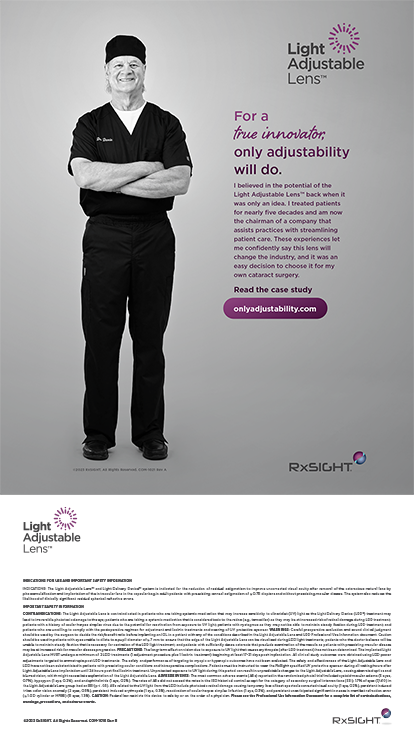
The Oracle Vision Council is a group of millennial ophthalmologists who are dedicated to furthering our field through innovation, discovery, and early adoption of vision technologies. In this installment of The Oracle Report, advances in glaucoma technologies that were part of the buzz at the AAO 2019 annual meeting in San Francisco are recapped.
Several technologies in the pipeline for glaucoma treatment received attention in the exhibit and lecture halls. Three investigational technologies in particular caught my eye at the meeting, and in this article I outline what we know so far about these innovations.
PRESERFLO MICROSHUNT
Of the technologies I will highlight in this article, the Preserflo MicroShunt (Santen) is the surgical device probably the closest to FDA approval. Formerly known as the InnFocus MicroShunt (InnFocus), the device received the CE Mark in 2012 and is in clinical use in Europe. InnFocus was acquired by Santen in 2016.
The Preserflo MicroShunt features an 8.5-mm tube made of a biocompatible material called poly(styrene-block-isobutylene-block-styrene), or SIBS. It has an outer diameter of 350 µm and a 70-µm diameter lumen, and its external fixation fins help to seal the device in place and prevent leakage and migration. The SIBS material has demonstrated biostability in preclinical and clinical studies, with minimal inflammation and scar tissue formation.1-3
An ongoing clinical trial is comparing standalone implantation of the Preserflo (ie, not associated with cataract surgery) with trabeculectomy. Davinder S. Grover, MD, presented topline 1-year data from that 2-year study during a hot topics session at the AAO meeting.4
The Preserflo is the first device for microinvasive glaucoma surgery (MIGS) to undergo a head-to-head comparative trial versus trabeculectomy in the United States and Europe, according to Santen. The ongoing prospective randomized controlled multicenter trial (NCT01881425) includes 527 patients being evaluated to determine efficacy and safety of the device in individuals with primary open-angle glaucoma whose IOP is not controlled on maximally tolerated glaucoma medications.5
At 1 year, patients with the device demonstrated mean reductions from baseline in IOP (21.1 to 14.2 mm Hg) and in numbers of medications needed (3.0 to 0.6), although the reductions were not as great as those in the patients who underwent trabeculectomy (IOP, 21.1 to 11.2 mm Hg; medications, 3.0 to 0.3). Dr. Grover also shared that 71.6% of patients in the Preserflo group and 84.8% in the trabeculectomy group were medication-free after the procedure.4
In a press release issued earlier this year, Santen stated that, at 1 year, the rate of hypotony at any time was greater in the trabeculectomy arm, 51.1%, versus 30.6% for those with the shunt.5 This finding suggests a possible advantage in safety with the device over trabeculectomy, and on the strength of these findings Santen intends to submit a request for premarket approval to the FDA, according to the company.
BEACON AQUEOUS MICROSHUNT
Another implantable device, the Beacon Aqueous Microshunt (MicroOptx), is at an earlier stage of development. The Beacon is designed to shunt aqueous humor from the anterior chamber to the surface of the eye, rather than to another area within the eye as other MIGS devices do.6 The Beacon device leaves a small hole or outflow channel through which aqueous spills onto the surface of the eye.
The strategy of shunting aqueous directly into the tear film eliminates episcleral venous pressure resistance and the risk of plugging that current technologies must overcome, according to the company. The device’s 30 x 48 µm hydrogel channel provides the resistance required to achieve predictable, precise flow control to lower IOP below 12 mm Hg, the company claims.
A multicenter trial of the Beacon (NCT04072016) is set to begin, with the purpose of evaluating the device in refractory glaucoma patients (ie, those with poor vision and high IOPs despite previous surgeries).
Because it is not covered by any tissue, the Beacon could potentially avoid the biggest problem with most glaucoma subconjunctival surgeries, which is scarring. With traditional shunts and filtration surgeries, the body tries to heal the channels that are created for outflow, producing scarring. The infection rate of a device like this is what most specialists will want to know.
In June, Carl Zeiss Meditec announced that it has become a shareholder in MicroOptx, a privately held company. The Beacon does not have regulatory approval in any region, so it is for investigational use only at this time.
BIMATOPROST SR
There is increasing interest in the field of glaucoma in finding ways to achieve sustained delivery of IOP-lowering medications. A durable delivery system would relieve patients of the daily responsibility of remembering to take their drops and also potentially improve compliance, and thereby the efficacy of our treatments. A number of companies are investing research and development efforts in this direction, but the one that may be closest to market with a solution is Allergan.
In July, the FDA accepted the company’s new drug application (NDA) for its bimatoprost sustained-release implant (Bimatoprost SR). The FDA is expected to take action on the submission in the first half of next year, according to the company.7 If approved, this would be the first sustained-release biodegradable implant for the reduction of IOP in patients with primary open-angle glaucoma or ocular hypertension.
In the two phase 3 ARTEMIS studies that supported the NDA application, Bimatoprost SR reduced IOP by 30% over the 12-week primary efficacy period, meeting the predefined criteria for noninferiority to timolol, the study comparator. E. Randy Craven, MD, presented these results during a glaucoma free paper session at the 2019 AAO meeting.8 The studies included 1,122 patients with primary open-angle glaucoma or ocular hypertension randomly assigned to the implant or timolol. After three treatments with Bimatoprost SR, more than 80% of patients did not need additional treatment to maintain IOP control for at least 12 months. The implant was well tolerated in most patients, and 36% of patients in the Bimatoprost SR group maintained IOP control with no additional medication after the first implant.
In the NDA studies, investigators were essentially injecting an implant every 4 months, but in practice we might be able to inject less frequently—perhaps every 6 months. The interesting thing is that the amount of medication in one injection is approximately equivalent to a single eyedrop of bimatoprost. That shows how much more efficient this delivery method is: The quantity in a single drop maintains lowered IOP for months at a time. So this development is potentially revolutionary, especially when we consider that we could essentially take compliance out of patients’ hands.
Other companies are working on similar technologies, but there is limited clinical trial experience to date. One thing is certain: We can look forward to durable implants as a development coming down the pike that will potentially be beneficial for our patients by reducing their burden of compliance while maintaining reliable efficacy.
CONCLUSION
The glaucoma pipeline is an exciting space, and as further developments occur the Oracle Vision Council and CRST will keep you up to date.
1. Pinchuk L, Riss I, Batlle JF, et al. The use of poly(styrene-block-isobutylene-block-styrene) as a microshunt to treat glaucoma. Regen Biomater. 2016;3(2):137-142.
2. Pinchuk L, Riss I, Batlle JF, et al. The development of a micro-shunt made from poly(styrene-block-isobutylene-block-styrene) to treat glaucoma. J Biomed Mater Res B Appl Biomater. 2017;105(1):211-221.
3. Acosta AC, Espana EM, Yamamoto H, et al. A newly designed drainage implant made of poly(styrene-block-isiobutylene-block-styrene): biocompatibility and function in normal rabbit eyes. Arch Ophthalmol. 2006;124:1742-1749.
4. Grover DS. Microshunts for glaucoma surgery. Paper presented at: the AAO 2019 annual meeting. October 12-15, 2019; San Francisco.
5. Santen announces topline pivotal data for DE-128 (MicroShunt) demonstrating reductions in intraocular pressure and medication use in patients with mild, moderate and severe primary open-angle glaucoma [press release]. Santen Pharmaceutical. August 30, 2019. https://ssl4.eir-parts.net/doc/4536/tdnet/1748459/00.pdf. Accessed October 31, 2019.
6. The Beacon Aqueous Microshunt. MicroOptx. https://microoptx.com/beacon-aqueous-microshunt/. Accessed October 31, 2019.
7. U.S. FDA accepts Allergan’s new drug application for bimatoprost sustained-release in patients with open-angle glaucoma or ocular hypertension [press release]. Allergan. July 17, 2019. https://www.allergan.com/News/Details/2019/07/US%20FDA%20Accepts%20Allergans%20New%20Drug%20Application%20for%20Bimatoprost%20SustainedRelease%20in%20Patients%20with%20Open. Accessed October 31, 2019.
8. Craven ER. Phase 3 evaluation of bimatoprost sustained-release implant in patients with glaucoma or OHT: Results at primary database lock. Paper presented at: the AAO 2019 annual meeting. October 12-15, 2019; San Francisco.




